|

by Nathan Falde
February 03,
2022
from
Ancient-Origins Website
Italian
version
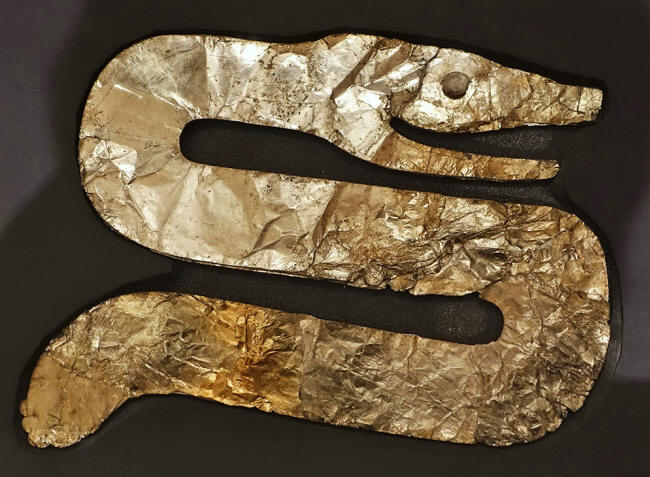
Hopewell culture serpent effigy,
Turner Group, Mound 4,
Little Miami Valley, Ohio.
Source: Daderot / Public domain
After enjoying centuries of stability, the prosperous Native
American
Hopewell culture suddenly went into
rapid and irreversible decline around the year 500 AD.
The reasons why this
happened have long been a topic for speculation, and a team of
researchers from the Departments of Anthropology and Geology at the
University of Cincinnati (Ohio) have now joined the debate to offer
a brand-new theory.
Analyzing rock samples collected from 11 archaeological sites in the
Ohio River Valley, these researchers have found physical evidence
that suggests an exploding comet may have played a significant role
in the Hopewell peoples' demise.
The samples included the
stony remnants of this disintegrating space object, which was
destroyed in an airburst that distributed its debris far and wide in
all directions.
These stony remnants, which are known as micrometeorites, possessed
qualities that revealed their true origin.
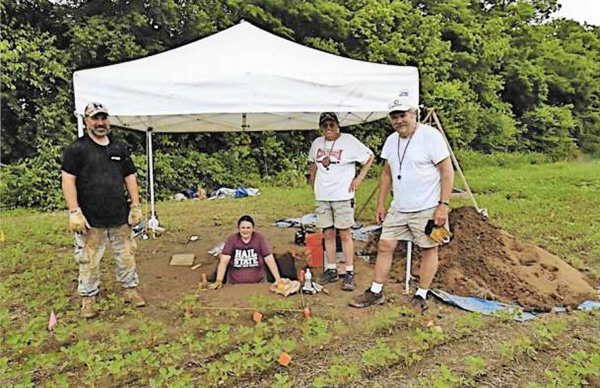
University of Cincinnati researchers
take sediment samples at a Hopewell culture site
at the confluence of the Ohio and Great Miami rivers.
(Larry Sandman / University of Cincinnati )
Meteorite
Impact on the Hopewell Culture Region
"Cosmic events like
asteroids and comet airbursts leave behind high quantities of a
rare element known as platinum," explained anthropologist and
lead study author Kenneth Tankersley in a University of
Cincinnati
press release.
"The problem is
platinum also occurs in volcanic eruptions. So, we also look for
another rare element found in non-terrestrial events such as
meteorite impact craters - iridium.
And we found a spike
in both, iridium and platinum."
Based on the results of
radiocarbon and typological dating procedures, the researchers
concluded that this catastrophic event would have occurred sometime
between the years 252 and 383 AD.
"This time period
coincides with historically documented near-Earth comets and
occurs immediately prior to the cultural downturn of
the
Hopewell," the University of Cincinnati researchers wrote
in an
article discussing their findings in Scientific Reports.
"The airburst event
may have created mass confusion resulting in an upheaval of the
social interaction sphere."
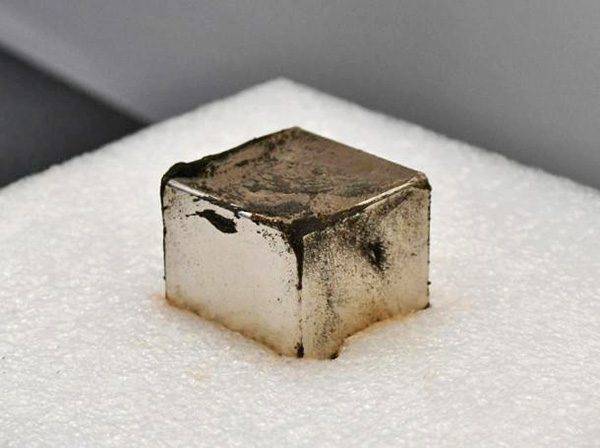
A magnet holds tiny micrometeorites
collected from sediment samples taken from
an
ancient Hopewell culture site.
Researchers say this evidence points to
a comet
airburst that devastated parts
of the
Ohio River Valley more than 1,500 years ago.
(Michael Miller / University of Cincinnati )
Previous research has revealed that the area of what is now the
eastern United States experienced an epidemic of massive and
ravaging wildfires during this period, which incinerated more than
9,200 square miles of forest and agricultural land.
The researchers found a
layer of charcoal deposits at the Hopewell culture sites along with
the micrometeorites, proving that these fires had occurred during
the same time period as the comet's near-Earth explosion.
If they crash into the earth, astronomical bodies like
comets and meteors can do great
damage to ecosystems within the zone of impact.
But if they explode in
the sky, the intense heat and wind generated by the blast, plus the
raining down of heavy, rocky debris from the exploding object, can
cause damage and destruction over a much broader geographical area.
This is what happened in the famous
Tunguska event of 1908, when a
comet or meteor passed through Earth's atmosphere and exploded in
the sky over Siberia.
The explosion leveled
more than 800 square miles of forest, leaving behind a scarred
landscape that is still visibly damaged to this very day...
Much like the Siberians
who lived near Tunguska, the Hopewell survivors of the third or
fourth century blast would have been surrounded by scenes of
unimaginable devastation.
Survivors who resided
near the epicenter of the explosion, which occurred over what is now
the
city of Milford in southwestern
Ohio, would have been especially shocked and traumatized by what
they experienced.
"It looks like this
event was very injurious to agriculture," said biology professor
and study co-author David Lentz, noting the impact of the
explosion on the food chain.
"People didn't have
good ways to store corn for a long period of time. Losing a crop
or two would have caused widespread suffering."
"And if the airburst leveled forests like the one in Russia," he
continued, "native people would have lost nut trees such as
walnut and hickory that provided a good winter source of food.
When your corn crop fails, you can usually rely on a tree crop.
But if they were all
destroyed, it would have been incredibly disruptive."
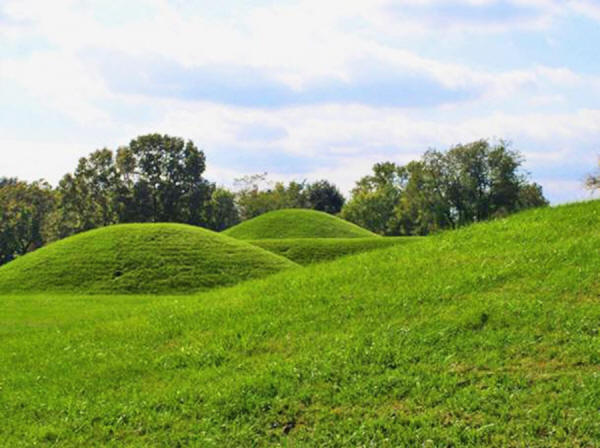
Hopewell culture mounds
from
the Mound City Group in Ohio.
(Heironymous
Rowe / CC BY-SA 3.0 )
Remembering the
Magnificent Hopewell Culture
The
pre-Columbian Hopewell culture was comprised of disperse
settlements of Native American peoples who occupied hundreds of
villages alongside rivers in what is now the northeastern and
mid-western sections of the United States.
The Hopewell culture was ethnically diverse, but united through
extensive trade networks that developed over the course of several
centuries.
The Hopewell peoples
reached the peak of their prosperity during a period that ranged
from approximately 200 BC to 500 AD, after which their culture
experienced a swift and sudden decline.
Although they essentially disappeared as a distinct people more than
1,500 years ago, the Hopewell did not vanish without a trace.
They left behind many
vast and impressive complexes of
large earthwork mounds, which can
be found in multiple states in the vast expanses of America's
Eastern Woodlands.
These ceremonial mounds were an expression of the Hopewell culture's
cosmological and spiritual belief systems, which is revealed by
their shapes, content, and alignments.
The mounds sometimes featured animals that would have been sacred to
the Hopewell, and sometimes were formed into geometric shapes that
likely had ritual significance or deeper spiritual meanings.
Just as significantly,
the locations of the mounds were not chosen at random:
Hopewell
mounds were carefully aligned to coincide in various ways with lunar
and solar cycles, or with the movement of stars across the night
sky.
In addition to their mound-building proclivities, the Hopewell were
also accomplished artists and craftspeople.
Hopewell archaeological
sites have yielded a remarkable bounty of expertly crafted items,
including pottery, sculptures, carvings, jewelry, textiles, tools,
and exotic ritual artifacts.
Artisans worked with
metal, bone, stone, and shells, producing a broad variety of
practical and decorative items that were traded freely between
villages and settlements.
Before the end came, the Hopewell culture seemed to be thriving.
They had lived in harmony
with nature, with their gods, and with each other for hundreds of
years.
It is clear that only a significantly disruptive and
destructive event or series of events could have brought about their
culture's sudden downfall.
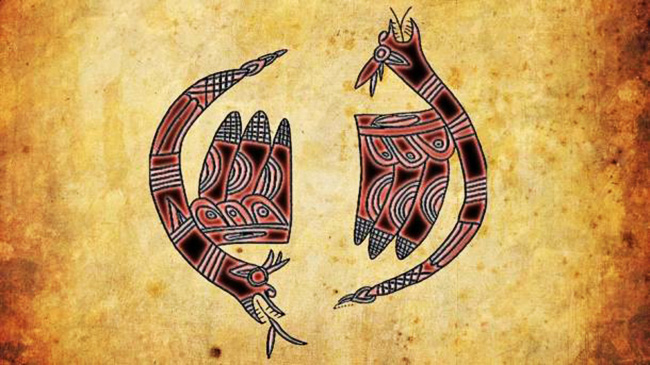
"The Miami Native Americans
tell of a horned serpent (pictured here)
that flew across the sky and dropped rocks
onto the land before plummeting into the river...
the Shawnee refer to a 'sky panther'
that had the power to tear down forests...
the Ottawa talk of a day
when the Sun fell from the sky."
(Chickasaw TV )
Where the
Storytelling Meets the Science
Further evidence for a world-altering event in ancient times can be
found in the oral traditions of Native American groups descended
from the Hopewell people.
"What's fascinating
is that many different tribes have similar stories of the
event," Professor Tankersley, who is Native American himself,
said.
"The Miami tell of a horned serpent that flew across the
sky and dropped rocks onto the land before plummeting into the
river... the Shawnee refer to a 'sky panther' that had the power
to tear down forest... the Ottawa talk of a day when the sun
fell from the sky."
Tankersley also
mentions legends passed down by the Wyandot, Algonquin,
and Iroquois people that describe sky-born catastrophes of
apocalyptic proportions.
And there is still more.
Near the epicenter of
the third- or fourth-century blast lies a set of Hopewell mounds
known as the Milford Earthworks.
Tellingly, one of
these mounds is shaped exactly like a comet.
While the evidence
proving the existence of the exploding comet is strong, there is
still much to be learned about its impact on the Hopewell culture.
"It's hard to know
exactly what happened. We only have a few points of light in the
darkness," Professor Lentz said.
"But we have this
area of high heat that would have been catastrophic for people
in that area and beyond."
"Science is just a progress report," commented geologist Steven
Meyers, another study participant.
"It's not the end.
We're always somewhere in the middle.
As time goes on, more
things will be found."
|






